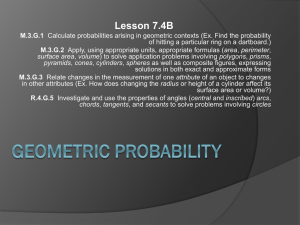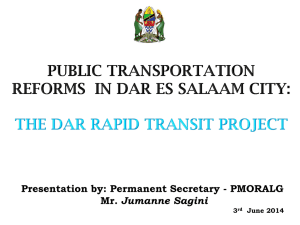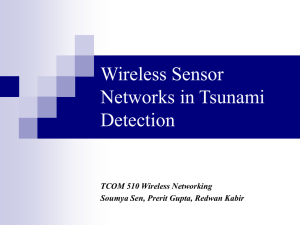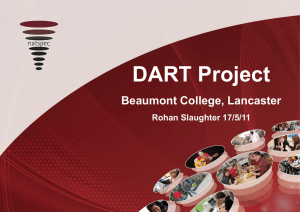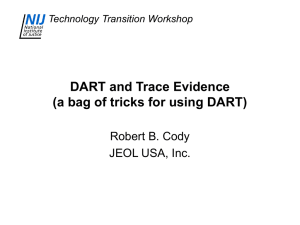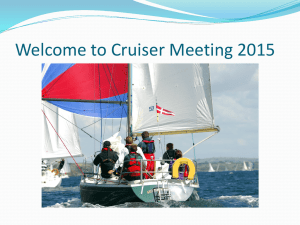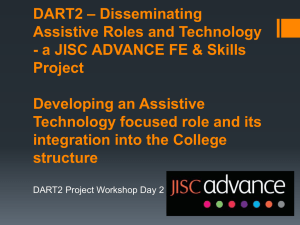DART - Deep-ocean Assessment and Reporting of Tsunamis
advertisement
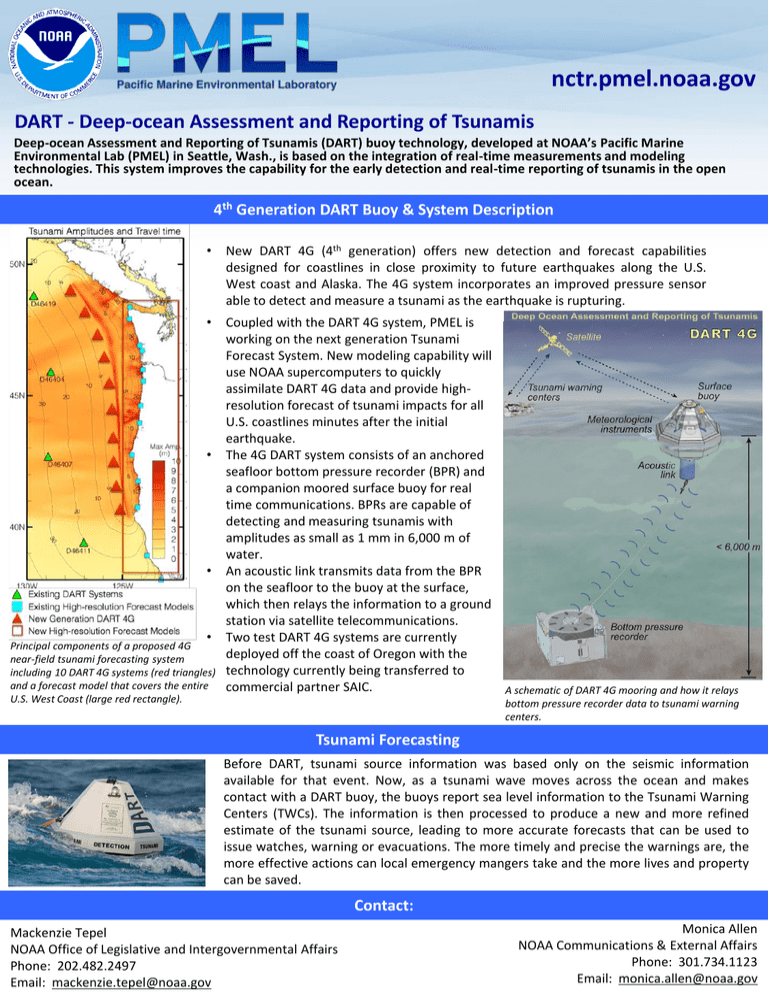
nctr.pmel.noaa.gov DART - Deep-ocean Assessment and Reporting of Tsunamis Deep-ocean Assessment and Reporting of Tsunamis (DART) buoy technology, developed at NOAA’s Pacific Marine Environmental Lab (PMEL) in Seattle, Wash., is based on the integration of real-time measurements and modeling technologies. This system improves the capability for the early detection and real-time reporting of tsunamis in the open ocean. 4th Generation DART Buoy & System Description • New DART 4G (4th generation) offers new detection and forecast capabilities designed for coastlines in close proximity to future earthquakes along the U.S. West coast and Alaska. The 4G system incorporates an improved pressure sensor able to detect and measure a tsunami as the earthquake is rupturing. • Coupled with the DART 4G system, PMEL is working on the next generation Tsunami Forecast System. New modeling capability will use NOAA supercomputers to quickly assimilate DART 4G data and provide highresolution forecast of tsunami impacts for all U.S. coastlines minutes after the initial earthquake. • The 4G DART system consists of an anchored seafloor bottom pressure recorder (BPR) and a companion moored surface buoy for real time communications. BPRs are capable of detecting and measuring tsunamis with amplitudes as small as 1 mm in 6,000 m of water. • An acoustic link transmits data from the BPR on the seafloor to the buoy at the surface, which then relays the information to a ground station via satellite telecommunications. • Two test DART 4G systems are currently Principal components of a proposed 4G deployed off the coast of Oregon with the near-field tsunami forecasting system including 10 DART 4G systems (red triangles) technology currently being transferred to and a forecast model that covers the entire commercial partner SAIC. A schematic of DART 4G mooring and how it relays U.S. West Coast (large red rectangle). bottom pressure recorder data to tsunami warning centers. Tsunami Forecasting Before DART, tsunami source information was based only on the seismic information available for that event. Now, as a tsunami wave moves across the ocean and makes contact with a DART buoy, the buoys report sea level information to the Tsunami Warning Centers (TWCs). The information is then processed to produce a new and more refined estimate of the tsunami source, leading to more accurate forecasts that can be used to issue watches, warning or evacuations. The more timely and precise the warnings are, the more effective actions can local emergency mangers take and the more lives and property can be saved. Contact: Mackenzie Tepel NOAA Office of Legislative and Intergovernmental Affairs Phone: 202.482.2497 Email: mackenzie.tepel@noaa.gov Monica Allen NOAA Communications & External Affairs Phone: 301.734.1123 Email: monica.allen@noaa.gov nctr.pmel.noaa.gov History of DART Technology 1st Generation: DART First generation DART buoy prototype development began in 1995 and the first 4 DART stations were deployed by August 2000. The 1st system was comprised of two separate parts (the bottom pressure recorder and surface buoy). Capable of only one-way communications to NOAA Tsunami Warning Centers, they transmitted four sea-level height observations per hour. 2nd Generation: DART II Second generation DART buoys, or DART II, were developed around 2004 offering twoway communications between the bottom pressure recorder and NOAA Tsunami Warning Centers allowing for real-time command and control and global deployment capability. The 2004 Indian Ocean tsunami fueled the development of the U.S. DART tsunami detection array and was completed in 2008 with 39 buoys, comprised largely of DART II systems, positioned around the Pacific basin, western Atlantic and Caribbean Sea. The array is now owned and maintained by the National Weather Service National Data Buoy Center. DART II buoy technology was also patented and transferred to an industry partner, SAIC, who now builds and sells DART buoys. Bottom Pressure Recorder (BPR) used in 1st and 2nd generation DART systems that measures a tsunami as it passes over. 3rd Generation: DART - ETD In 2007, PMEL developed the third generation DARTs, or Easy to Deploy (ETD) systems that integrate the bottom pressure recorder and surface buoy into one easy to deploy system. DART ETD changed the way deep-water oceanographic moorings were deployed, utilizing small vessels, minimally trained staff and requiring less than 30 seconds to deploy. They offer the same two-way communications as the DART II and are also available from SAIC with the first commercial deployment in 2010. 4th Generation: DART 4G DART buoys deployed around the world as of October 2014. Red dots indicate those in the U.S. DART array. 4th Generation DART buoys, or 4G, began development in 2013 for the measurement of near-field tsunamis. The DART 4G is an enhanced version of the DART-ETD that incorporates advancement of sensors, software and power management to detect and measure near-field tsunami with unprecedented resolution. The improved pressure sensor is able to detect and measure a tsunami closer to the earthquake source providing valuable information to warning centers even faster and allowing the moorings to be placed closer to earthquake zones (and consequently the coastline).

